Ensign Rebecca Ann Britton
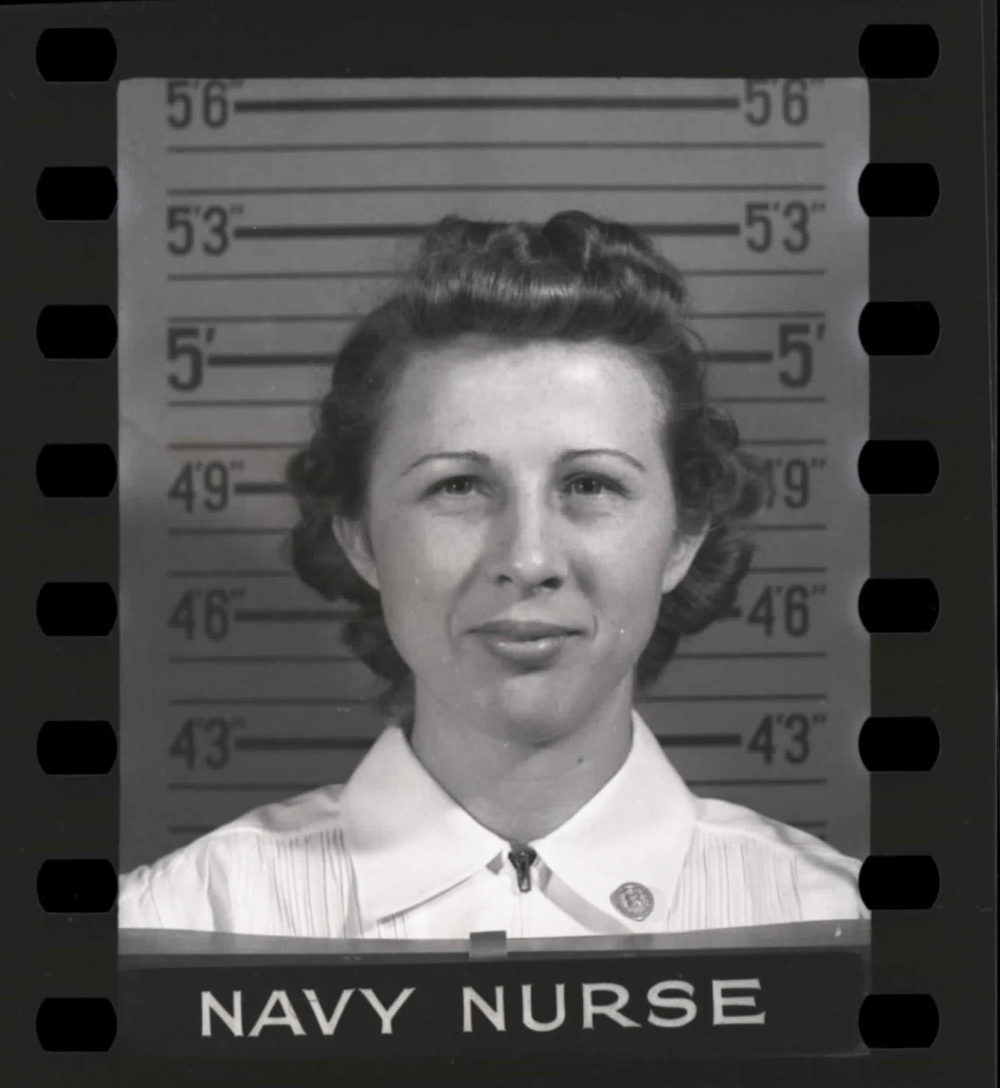
- Unit: U.S. Navy Nurse Corps
- Service Number: 95178
- Date of Birth: September 30, 1915
- Entered the Military: March 18, 1941
- Date of Death: January 25, 1943
- Hometown: Chambers County, Alabama and Loraine, Texas
- Place of Death: Naval Air Station, Kanoehe Bay, Hawaiʻi
Mentored by Mr. James O’Keeffe
Northwest Early College High School
2022/2023
Early Life
Rebecca Ann Britton was born September 30, 1915, in Five Points, Chambers County, Alabama. She was one of eleven children born to Edward Wayne and Minnie Lola Britton, née Higgins. She was also one of two girls, the other her older sister Lurline.
In 1925 the Britton family relocated to Loraine, Texas, where numerous relatives lived, including L.T. Britton, elected mayor in 1923. Others in Rebecca’s family at Loraine, such as her cousin, Harold Britton, also served in World War II.
Rebecca earned placement on Loraine High School’s honor roll during her teenage years. She was involved in many activities like tennis, volleyball, and theater. Rebecca even portrayed Evelyn Falconer in a play called Sweet Mama at the Lone Star schoolhouse in nearby Colorado City during her ninth grade year.
Like many of Loraine’s residents, Rebecca’s father, Edward, earned his living through cotton tenant-farming. Tenant-farming was a system in which the person who grows and maintains the land does not own it but still uses it to take advantage of its resources. This system was crucial in Mitchell County as it was home to more than 1,000 tenant farmers and because it assisted with land management while family members were away at war. After high school, Rebecca relocated to California, residing in Indio in 1935 and then in San Diego by 1940.


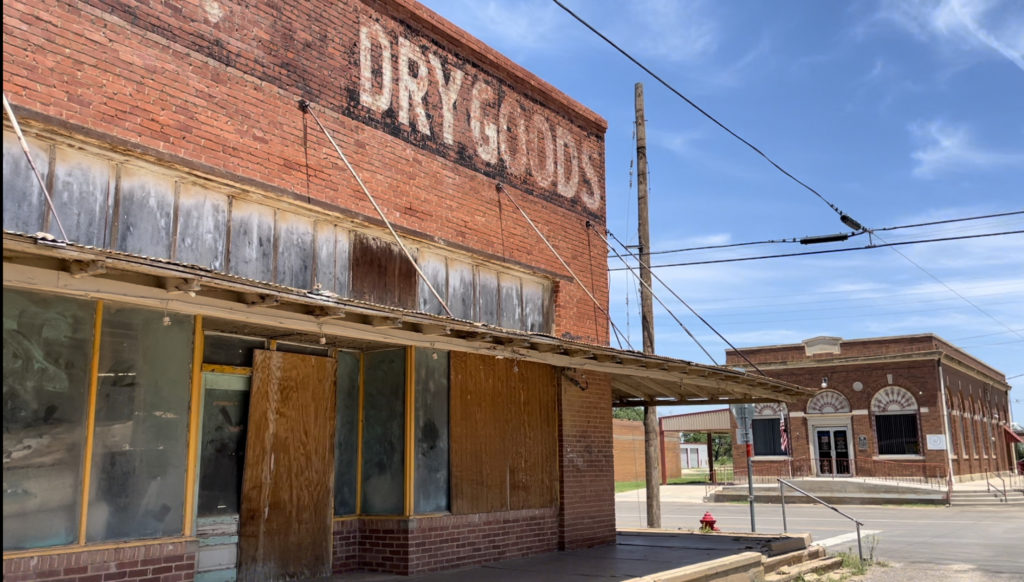
Homefront
Loraine and Mitchell County, Texas
Loraine, where Rebecca attended junior high and high school, was a rural farm, ranch, and fossil-fuel-producing community in the Permian Basin region of west Texas. The discovery of oil in surrounding Mitchell County in 1920 provided a stable source of jobs and income for its residents through the later Great Depression. It became a key source of petroleum for the war effort after the United States entered World War II, producing a peak of 538,000 barrels in 1944.
Just as vital to the war were the cattle ranching and cotton industries, the latter of which, ironically, had already helped make Texas the single largest U.S. exporter of cotton to Japan prior to World War II. The cotton industry in Mitchell County would become heavily dependent on migrant workers from Mexico during World War II. Loraine began operating a Latin American migrant reception center in a converted dairy barn each September, hosting some 4,000 migrant cotton pickers in 1945.
Mercy College of Nursing
Now a cancer-treatment facility at Scripps Mercy Hospital in San Diego, California, the Mercy College of Nursing originated as the St. Joseph’s Training School for Nurses in 1903. Rebecca Britton completed her three years of nurse training at the renamed college in January 1939. A class of 1934 graduate described a typical nursing student’s 12-hour day, which began at 7:00 a.m. with serving hospital patients “breakfast & fresh water” before providing “bed baths, linen changes, treatments and medicines.” Students then attended classes in the afternoons before returning to their hospital rounds until 7:00 p.m.
Mare Island
Mare Island Naval Shipyard, Ensign Britton’s first duty station after her appointment to the U.S. Navy Nurse Corps, was home to the first official Naval hospital on the west coast of the United States, having opened its doors in 1871. The hospital had treated thousands of U.S. Navy personnel and their families through the 1918 Spanish Influenza epidemic. By the 1930s, it was renowned for its prosthetics and reparative plastic surgery ward. Ensign Britton likely treated burn survivors and amputees from the December 7, 1941, attack on Pearl Harbor, as many were sent to Mare Island for treatment in the days and weeks following the attack.
Naval Air Station Kaneohe Bay
The Naval Air Station (NAS) at Kaneohe Bay on Oahu was Ensign Britton’s final duty station before she died in 1943. Located on the island’s northeast coast, NAS Kaneohe Bay was attacked eight minutes before Pearl Harbor on December 7, 1941. The new Aeia Naval Hospital was still under construction when Britton arrived with the first Navy nurses sent to Hawaiʻi after the Pearl Harbor attack. The finished 1,650-bed facility was commissioned in November 1942, and it is here where Britton served until dying on active duty the following January.

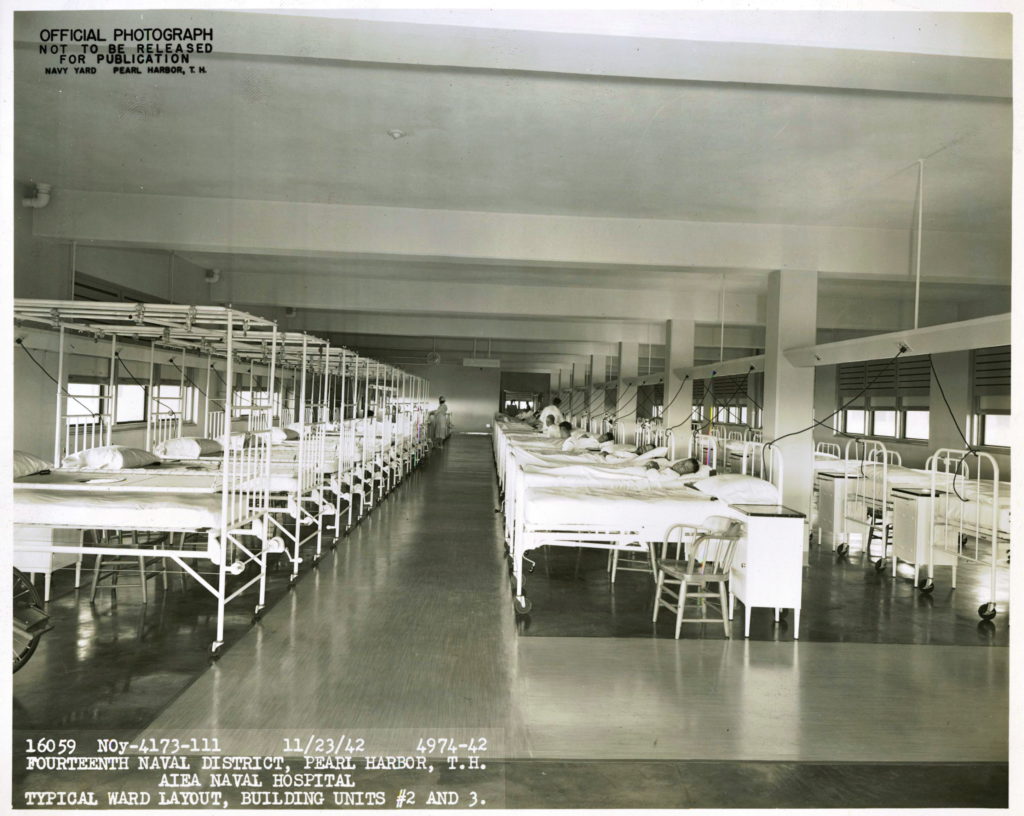
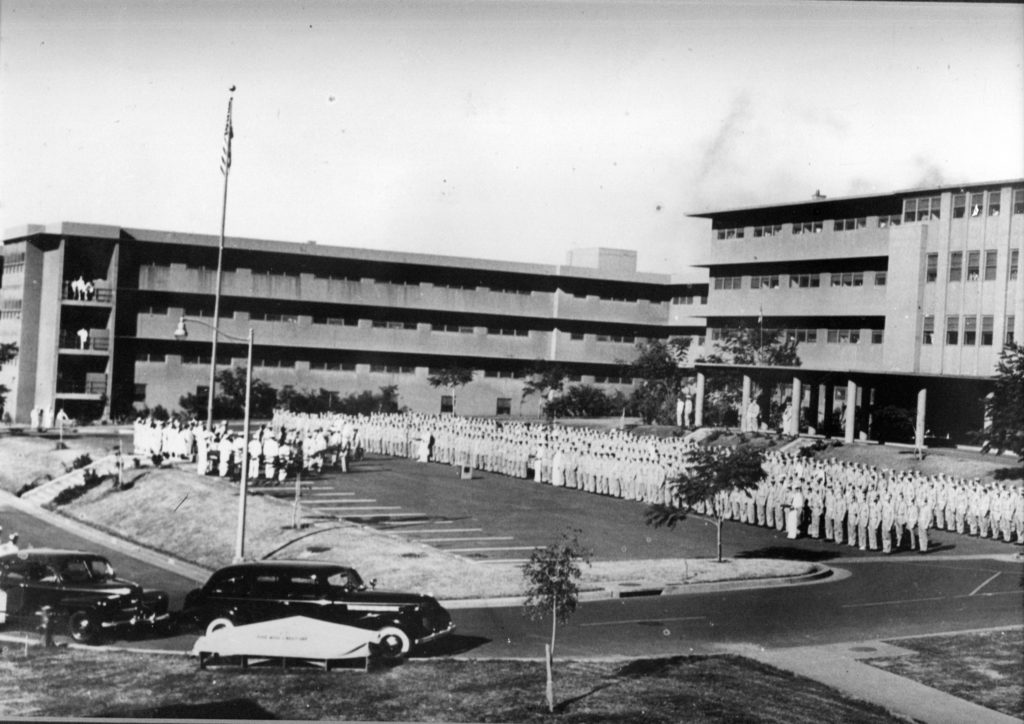
Military Experience
After Rebecca Britton graduated from Mercy College on January 22, 1939, her abilities in nursing led her to express her interest in joining the U.S. Navy. She was described as a “good bedside nurse” on her School of Nursing certificate from January 1941. This compliment reflected her ability to care for patients with compassion and expertise.
In November 1940, Britton expressed her desire to join the Navy Nurse Corps in a letter to the War Department. “I am a graduate registered nurse and very much interested in naval nursing,” she wrote, demonstrating how she genuinely wanted to play a role in the aid of servicemen and women. On March 18, 1941, Ensign Rebbecca Ann Britton joined the United States Navy Nurse Corps and was stationed at Mare Island Naval Hospital in Vallejo, California.
Ensign Britton’s duties as a Navy nurse were varied and vital to the well-being of servicemen and women. These included disaster response, treating wounded and injured soldiers, and providing nursing care. Rebecca’s hard work as a nurse was recognized when, after completing her probationary period in September 1941, she received a letter of recommendation from Chief Nurse Helen S. Wood for retention by the Navy Nurse Corps.
In her hometown, Ensign Britton was celebrated in an article titled “Our Boys in Service.” She was recognized for her service as a Navy Nurse who served as a “beacon of hope for the community for the safety of their servicemen.”
On Sunday, December 7, 1941, the Kaneohe Naval Air Station was attacked several minutes before the attack of Pearl Harbor. In January 1942, Ensign Britton arrived on the first ship of nurses sent to Marine Corps Air Station Kaneohe Bay to aid the wounded from the initial attack. In the following months, she would also care for wounded returned from the naval “island-hopping” campaigns as the United States reclaimed Pacific theater territories for the Allied Forces.
Tragically, Ensign Britton’s life took an unexpected turn while stationed at Kaneohe Bay. According to Rebecca’s niece, Janis Lukens, there were so many wounded that Ensign Britton continued to care for the injured even though she contracted appendicitis that January.
As detailed by the attending medical officer, Navy Captain J. L. Shipley, on January 24, 1943, Ensign Britton was admitted to the sick list and underwent surgery in hopes of aiding her with her acute appendicitis. Following the surgery, she had a sudden collapse without reasonable cause with respiratory and cardiac failure. On January 25, 1943 Ensign Britton underwent a secondary collapse leading to her death.
Her death certificate recorded her cause of death as “status lymphaticus.” It was later affirmed that an enlargement of her lymph nodes likely complicated the surgery. A letter from Captain Shipley to Rebecca’s father in February 1943 conveyed that “[i]t is some comfort that we did not operate unnecessarily.” Even though it resulted in her passing, these words comforted the grieving family, knowing that every effort possible was made to address her condition.
After Ensign Britton’s death, Navy Nurse Corps Superintendent Sue S. Dauser paid a heartfelt tribute in a February 8, 1943 letter. She expressed that Rebecca had won the love and goodwill of all who had the privilege of knowing her, proving to be a testament to her impact as a nurse and as a person.
A bitter irony about Ensign Britton’s death was the lack of antibiotics that could have saved her life. It would not be until later, in July of 1943, when penicillin, a groundbreaking antibiotic, was first administered to United States military personnel, revolutionizing medicine and potentially saving countless lives in the future.
After the war, her sister Lurline requested that a headstone be placed in the family’s plot in Texas, a request the government denied.
In her brief but heroic life, Rebecca touched the lives of many, leaving behind a profound impact that inspires those in the medical and military communities.

Eulogy
Ensign Rebecca Ann Britton was a brave and dedicated individual who made significant contributions to her country during World War II.
Rebecca Ann Britton was born September 30, 1915, in Five Points, Chambers County, Alabama. From 1928 to 1932, Rebecca attended Loraine High School, participating in volleyball, tennis, and theater and earning placement on her school’s honor roll. After high school, Rebecca relocated to California and graduated in 1937 from the Mercy College of Nursing at San Diego. After graduating, Rebecca worked as a trained nurse in private homes until 1940.
On March 18, 1941, Ensign Rebbecca Ann Britton joined the United States Navy Nurse Corps. For the rest of 1941, Rebecca was stationed at Mare Island Naval Hospital in Vallejo. Here under challenging conditions she cared for injured soldiers, tracked and controlled diseases, and kept up medical records. On Sunday, December 7, 1941, the Kaneohe Naval Air Station was attacked minutes before the attack on Pearl Harbor, injuring many. In January 1942, Ensign Britton was sent on the first ship of nurses that arrived at Naval Air Station Kaneohe Bay to aid the wounded from the attack and later naval campaigns to come over the next year.
According to Rebecca’s niece, Janis Lukens, during Ensign Britton’s year of service in Hawaiʻi there were such a large number of wounded, so she continued to care for the injured even as she contracted appendicitis. Nurse Britton did not let anyone know she was sick until her appendix burst. On January 25, 1943, at 28, Ensign Britton died of acute appendicitis after sacrificing her life for the well-being of Allied sailors and soldiers.
We are forever indebted to Rebbecca Ann Britton and all who have given their lives for our freedom.
May she rest in peace.
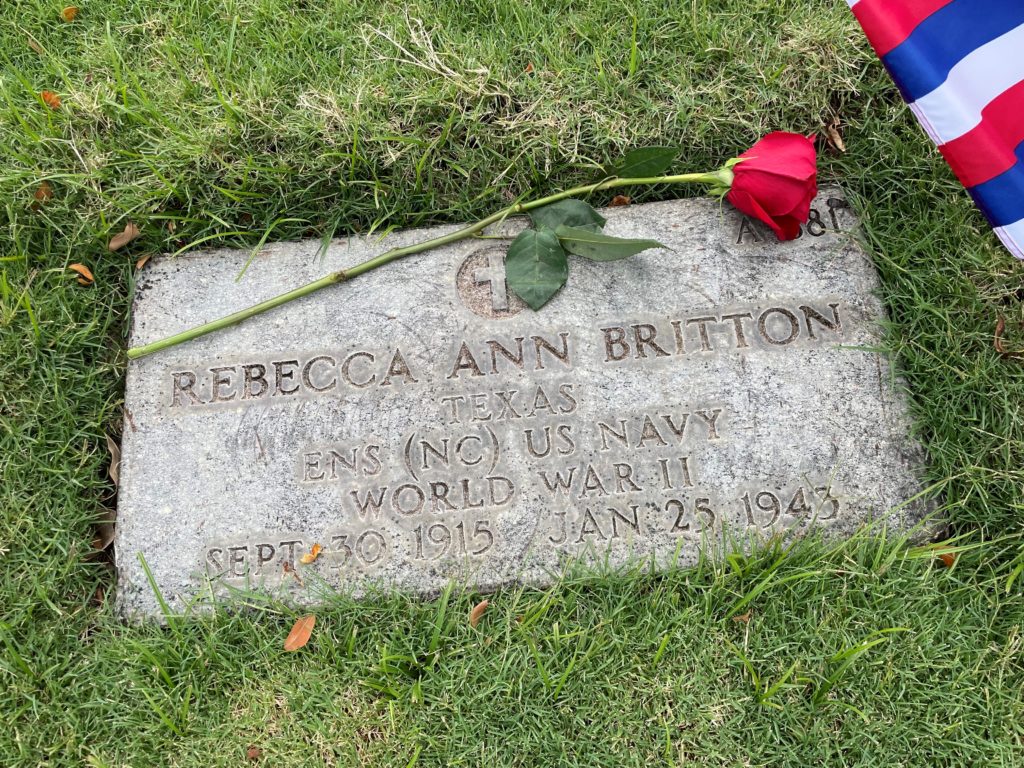

Reflection
First and foremost, researching my silent hero from World War II has taught me the importance of endurance. Discovering the story of a hero who may have been forgotten or overlooked requires a tenacious spirit. I have learned to welcome challenges and obstacles as prospects for development, and I will maintain this resilience with me in all future endeavors.
This experience has honed my questioning and critical thinking skills. Throughout the readings we were provided, the process of investigating primary sources, and historical records, I have become a better researcher. For example, it was difficult to find all the details about her life as many pieces were incomplete. By going more in-depth into her life and her family’s life, I put the pieces together and connected her story.
Furthermore, writing the eulogy taught me the power of storytelling. I could connect facts about Rebecca’s life to capture her spirit and her influence on the world. By researching her life, I learned about her and her willingness to sacrifice, her hometown, and her life before the war. My research showed me how she was just like one of us until she sacrificed her life for the safety of others. After this process, I recognize that stories can inspire and educate, and I will utilize this power to create meaningful connections.
This wonderful experience has enriched my understanding of history, taught me worthwhile skills, and planted a sense of purpose in me. I am excited to apply the lessons gained from researching my Silent Hero from World War II in my life and continue honoring the stories of those who often are overlooked. Pursuing my education, I hope to apply my teamwork and research skills to advance in any field I choose. Through my research, I can now better understand what it takes to connect information and data analysis. The Sacrifice for Freedom®: World War II in the Pacific Student and Teacher Institute has taught me to look beyond the textbook. Bringing this back to my border-town community will be significant and allow us to understand what it means to be a hero.
Bibliography
Primary Sources
Aiea Naval Hospital . . . Photograph. 1940s. U.S. Marine Corps (111031-M-1234A-005). https://commons.wikimedia.org/wiki/File:USMC-111031-M-1234A-005.jpg.
The Aiea Naval Hospital conducts an all-hands formation . . . Photograph. January 1, 1944. U.S. Marine Corps (111031-M-1234A-001). https://commons.wikimedia.org/wiki/File:USMC-111031-M-1234A-001.jpg.
Alabama. Chambers County. 1920 U.S. Census. Digital Images. http://ancestry.com.
California. San Diego County. 1940 U.S. Census. Digital Images. http://ancestry.com.
“Lone Star News.” The Colorado Record [Colorado, Texas], January 17, 1930. http://mitchellcounty.advantage-preservation.com/viewer/?k=rebecca%20britton&i=f&d=01011930-12311959&m=between&ord=k1&fn=colorado_record_usa_texas_colorado_19300117_english_3&df=1&dt=10&cid=2744.
“Loraine Girl Dies in Navy.” Mitchell County News [Loraine, Texas], January 28, 1943. http://mitchellcounty.advantage-preservation.com/viewer/?k=rebecca%20britton&i=f&d=01011930-12311959&m=between&ord=k1&fn=mitchell_county_news_usa_texas_loraine_19430128_english_1&df=1&dt=10&cid=2744.
“Loraine Navy Nurse Dies on Foreign Duty.” Fort Worth-Star Telegram [Fort Worth, Texas], February 6, 1943. Newspapers.com (125028833).
“Mrs. Britton Buried Sunday.” The Mitchell County News [Loraine, Texas], June 20, 1941. http://mitchellcounty.advantage-preservation.com/viewer/?k=rebecca%20britton&i=f&d=01011930-12311959&m=between&ord=k1&fn=mitchell_county_news_usa_texas_loraine_19410619_english_1&df=1&dt=10&cid=2744.
“Our Boys in Service.” The Mitchell County News [Loraine, Texas], November 12, 1942. http://mitchellcounty.advantage-preservation.com/viewer/?k=rebecca%20britton&i=f&d=01011930-12311959&m=between&ord=k1&fn=mitchell_county_news_usa_texas_loraine_19421112_english_5&df=1&dt=10&cid=2744.
Rebecca A. Britton, Individual Deceased Personnel File, Department of the Army.
Rebecca A. Britton, Official Military Personnel File, Department of the Navy, Records of the Bureau of Naval Personnel, RG 24, National Archives and Records Administration – St. Louis.
Rebecca A. Britton, Official Navy ProJacket, Department of the Navy. National Archives and Records Administration – St. Louis.
Rebecca A. Britton. U.S. National Cemetery Interment Control Forms, 1928-1962. Digital Images. https://www.ancestry.com.
Rebecca A. Britton. U.S., Veterans’ Gravesites, ca.1775-2019. https://ancestry.com.
Rebecca Ann Britton. Honolulu, Hawai’i, U.S., National Memorial Cemetery for the Pacific (Punchbowl) 1941-2011. https://www.ancestry.com.
Rebecca Ann Britton. U.S., Headstone Applications for Military Veterans, 1861-1985. Digital images. https://ancestry.com.
“San Diego Navy Nurse Dies in Honolulu.” The Los Angeles Times [Los Angeles, California], January 31, 1943. Newspapers.com (125029330).
Texas. Mitchell County. 1930 U.S. Census. Digital Images. http://ancestry.com.
Secondary Sources
Dally, Ann. “Status Lymphaticus: Sudden Death in Children from ‘Visitation of God’ to Cot Death.” Medical History 41, no. 1 (January 1997): 70-85. https://www.ncbi.nlm.nih.gov/pmc/articles/PMC1043871/?page=10.
“Aiea Naval Hospital History.” Defense Visual Information Distribution Service. Updated July 24, 2019. Accessed August 22, 2023. https://www.dvidshub.net/news/332862/aiea-naval-hospital-history.
Fosbinder, MSN, RN, Donna. “Hospital Based Nursing Schools in San Diego, 1900-1970.” The Journal of San Diego History. 35, no, 2 (Spring 1989). https://sandiegohistory.org/journal/1989/april/hospital/.
“A Historical Look at the Mare Island Naval Hospital.” CalEXPLORnia. Updated November 23, 2022. Accessed August 23, 2023. https://www.calexplornia.com/a-historical-look-at-the-mare-island-naval-hospital/.
“Kaneohoe Naval Air Station.” Historic Hawaiʻi Foundation. Updated August 18, 2014. Accessed August 23, 2023. https://historichawaii.org/2014/08/18/kaneohe-naval-air-station/.
Loeffler, Paul. “Nurse Recalls Mare Island [Interview with Peggy Berghold].” Hometown Heroes Radio. Updated July 18, 2015. Accessed August 22, 2023. https://www.hometownheroesradio.com/nurse-recalls-mare-island/.
Lukens, Janis. Lukens Family Tree. https://ancestry.com.
“Pearl Harbor Navy Medical Activities.” Naval History and Heritage Command. Updated May 20, 2023. Accessed August 22, 2023. https://www.history.navy.mil/research/library/online-reading-room/title-list-alphabetically/p/pearl-harbor-navy-medical-activities.html.Sarnecky, Mary T. A History of the U.S. Army Nurse Corps. Philadelphia: University of Pennsylvania Press, 1999.


